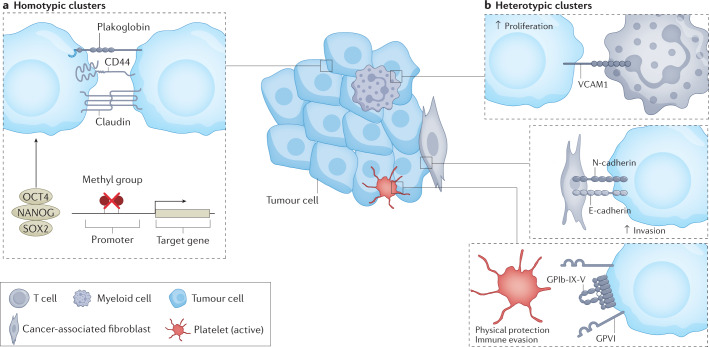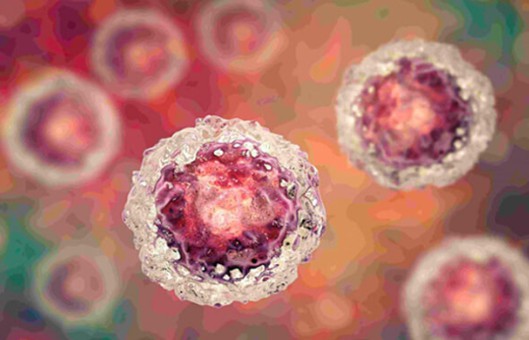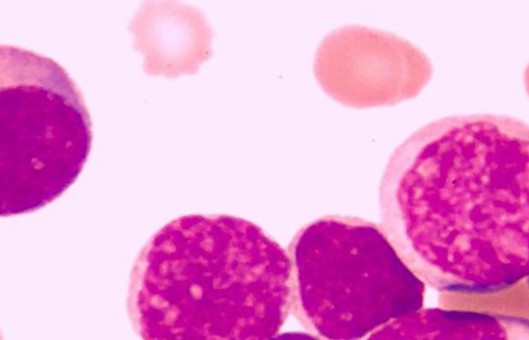Biological Features of Circulating Tumor Cells
Nature Reviews Cancer. 2023 Feb; 23 (2): 95-111.
Authors: Ring A, Nguyen-Sträuli BD, Wicki A, Aceto N
INTRODUCTION
In recent years, exceptional technological advances have enabled the identification and interrogation of rare circulating tumor cells (CTCs) from blood samples of patients, leading to new fields of research and fostering the promise for paradigm-changing liquid biopsy-based clinical applications. Analysis of CTCs has revealed distinct biological phenotypes, including the presence of CTC clusters and the interaction between CTCs and immune or stromal cells, impacting metastasis formation and providing new insights into cancer vulnerabilities.
CTC Phenotypic Heterogeneity and CTC Clusters
- The polyclonal nature of metastatic colonies and the mutually beneficial or synergistic interactions between subclones indicate that cancer spread occurs not only via single CTCs but also via heterogeneous CTC clusters. Several studies show that CTC clusters, comprising a minority of the total CTC events in the peripheral circulation, display up to a 100-fold increase in metastatic potential compared with individual CTCs.
- Clustering occurs not only between CTCs (homotypic) but also between CTCs and other cell types (heterotypic clusters), including platelets, myeloid cells, and CAFs. The interaction of CTCs with platelets occurs rapidly in the circulation, promoting plasticity and metastasis-initiating capacity. Heterotypic adherents' junctions between invasive cancer cells and stromal CAFs mediated by E-cadherin and neural cadherin (N-cadherin), respectively, have been shown to promote collective invasion, where CAFs function as leader cells with migratory–invasive features and support metastasis.
 Fig. 1 Biological features of circulating tumor cell clusters.
Fig. 1 Biological features of circulating tumor cell clusters.
Molecular Heterogeneity of CTCs
- By studying the genomic, transcriptomic, and epigenetic profiles of CTCs, we can further explore their biology. The development of single-cell technologies and sophisticated bioinformatics tools has allowed the dissection of rare CTC populations at single-cell resolution. For example, single-CTC analysis has uncovered copy number variants, therapeutic targets (for example, HER2), and resistance mutations (for example, in PIK3CA) that only partially overlap with primary tumors or metastatic lesions from the same patient.
- An in vivo loss-of-function CRISPR screen identified specific molecular dependencies required by CTCs for the successful completion of the metastatic cascade. For example, knockout of the gene encoding PLK1 led to a remarkable reduction in CTC intravasation, as well as metastasis formation. Other regulatory elements, including long non-coding RNAs such as colon cancer-associated transcript 1 (CCAT1) and HOX transcript antisense RNA (HOTAIR), have been shown to function as key pro-metastatic contributors by inducing microenvironmental changes that promote invasion, migration, and organotropic colonization via the TGFβ–ZEB1/ZEB2 axis or the nuclear factor-κB (NF-κB) pathway.
Timing of CTC Release
In addition to the aforementioned dimensions of heterogeneity, propagation dynamics of CTCs are emerging as an equally important element for tumor cell dissemination. The role of the circadian rhythm for tumor onset and growth dynamics has been investigated and explored clinically via the concept of chronotherapy. This aims to increase the efficacy of antineoplastic drugs by administering treatment at optimized times.
Detection and Analysis of CTCs
- The past decade resulted in several technological advances to improve CTC detection and analysis, exploiting distinct characteristics and phenotypes of CTCs. Broadly speaking, these can be divided into antigen-dependent and antigen-independent methods.
- Antigen-agnostic detection technologies exploit physical properties such as size, charge, density, or elasticity for CTC enrichment. Filter-based devices, density gradient centrifugation, capture surfaces, and microfluidic systems all enable the detection of CTCs based on physical properties. Multimodality approaches are being developed to further increase sensitivity and specificity.
Creative Bioarray Relevant Recommendations
| Product Types | Description |
| SuperBeads® Human CTC Isolation Kit (Direct) | Use SuperBeads® Human CTC Isolation Kit (Direct) to isolate CTCs directly from human whole blood by immunomagnetic negative selection. The kit depletes other kinds of cells. The negatively isolated Human CTCs are left in the sample and have not been touched with the SuperBeads. |
| Circulating Tumor Cell (CTC) FISH | Creative Bioarray now offers a full line of circulating tumor cell fluorescence in situ hybridization (FISH) services, from enrichment of CTCs, standardized testing of validated assays, and custom development of new assays. |
RELATED PRODUCTS & SERVICES
Reference
- Ring A, et al. (2023). "Biology, vulnerabilities and clinical applications of circulating tumor cells." Nat Rev Cancer. 23 (2), 95-111.



